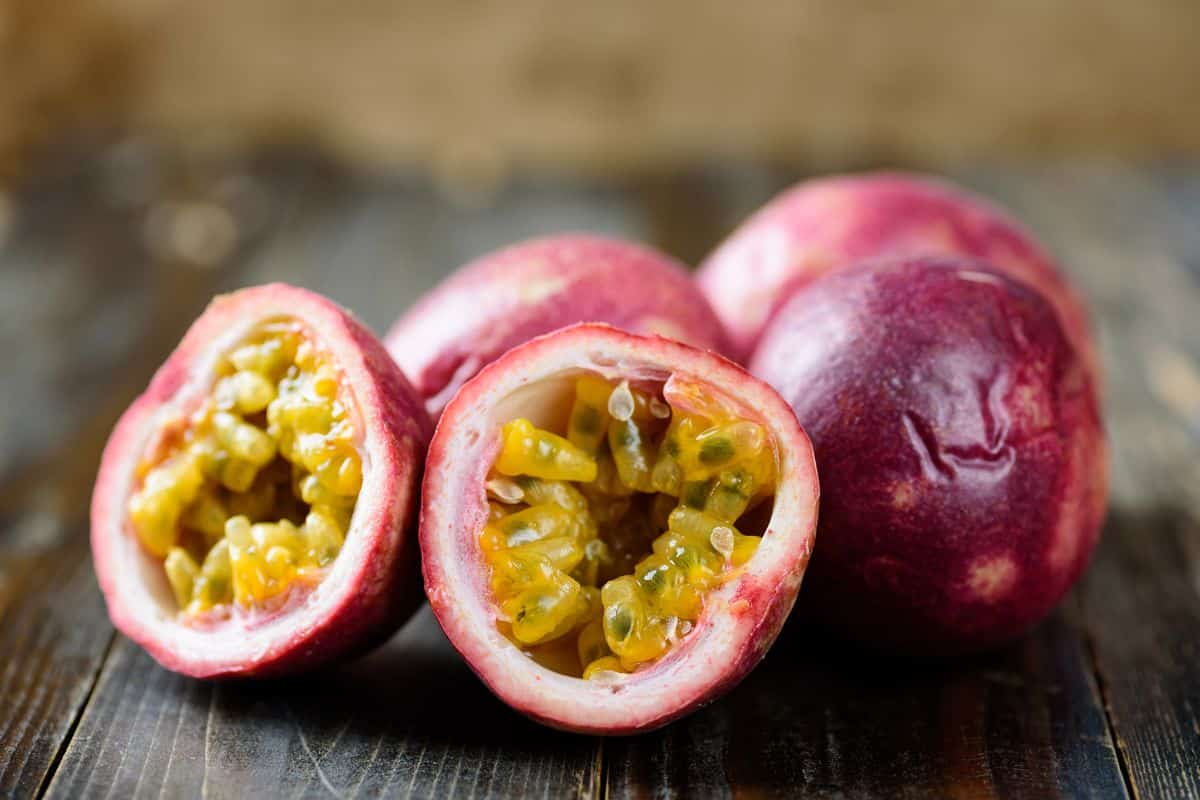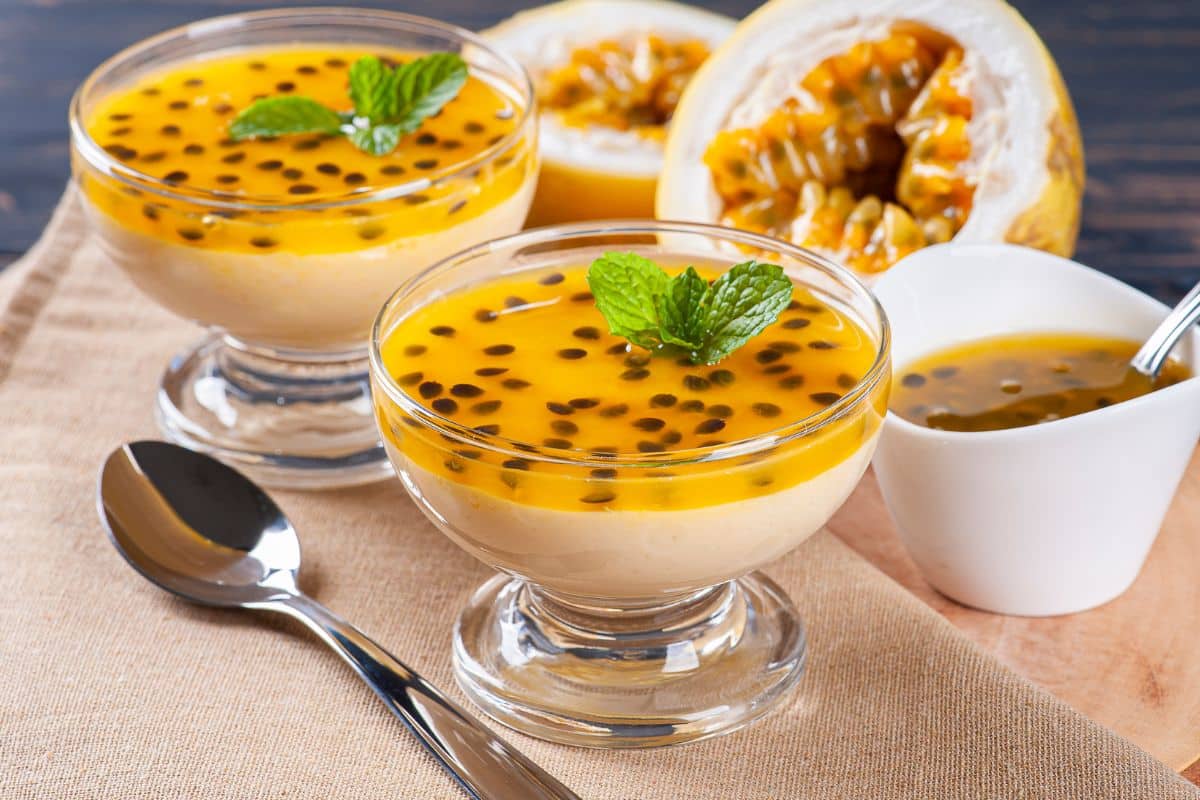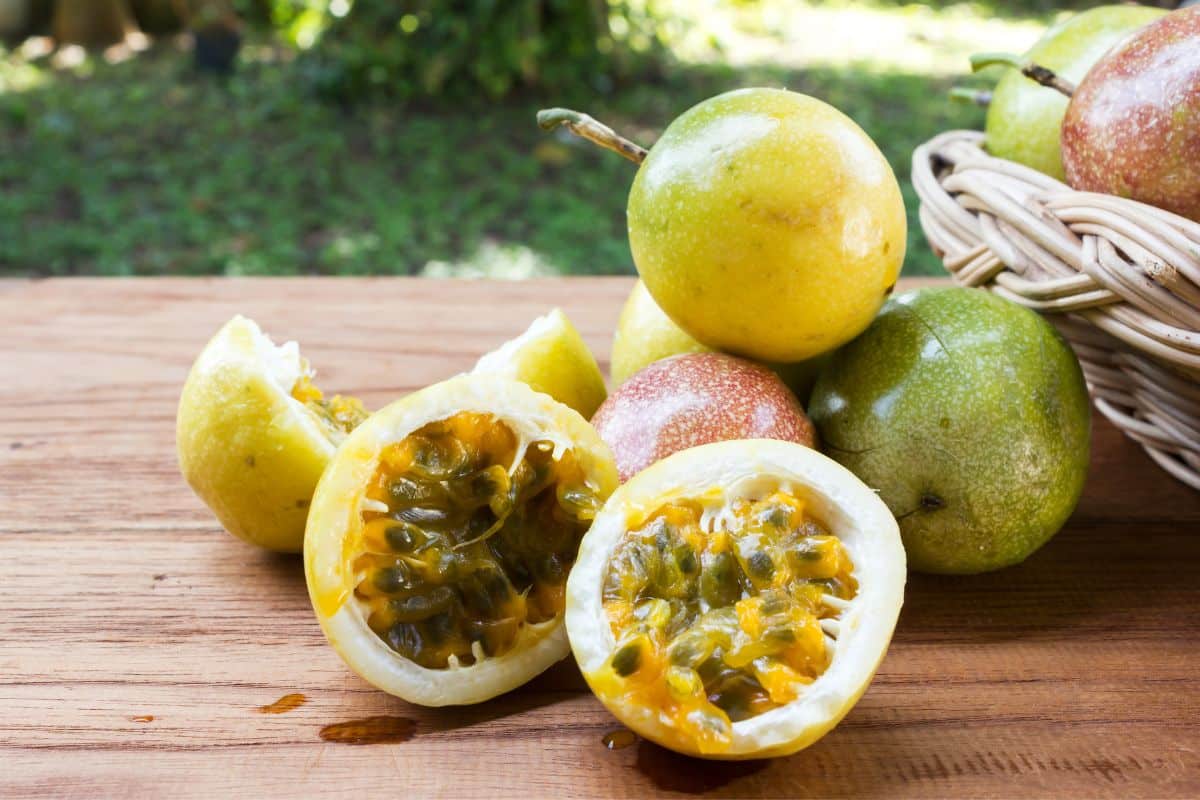Passion fruit is a juicy, delicious fruit that has been enjoyed by many people all over the world.
It has a unique flavor that can be described as sweet, tart, and tropical. But what does passion fruit really taste like, and is it a good fruit to enjoy?

In this article, we will explore the flavor of passion fruit and answer the question whether or not it tastes good.
What Is Passion Fruit?
Passion fruit is a tropical fruit that originated from South America. Today, it is widely grown in tropical and subtropical areas.
This delicious fruit comes in different varieties with varying sizes and colors of skin, and each type has distinguishing characteristics.
Passion fruit has a tough and leathery skin that is typically purple but sometimes comes in yellow. The inside of the fruit contains a white pith that covers the yellow pulp, where you’ll find the dark seeds.
One of the unique characteristics that sets passion fruit apart is the texture of the skin and the seeds.
The skin is rough and leathery, while the seeds have a distinct crunchiness to them. Passion fruit seeds are edible and filled with dietary fiber.
What Does Passion Fruit Taste Like?
Passion fruit flavor has a distinctive sweet and sour taste. The first thing you’ll notice is the tangy tartness, which is then balanced out by a sweet undertone.
Depending on the variety and level of ripeness, the flavors can vary, with some passion fruits being sweeter than others.
Passion fruits come in a range of colors, with the most common being purple or yellow.
Purple passion fruits are known for their strong and intense flavors, while yellow passion fruits are milder in taste with a more citrusy undertone.
The color of the pulp can also differ slightly between varieties, with some being a bright yellow color and others being closer to orange.
As mentioned earlier, one of the unique aspects of passion fruits is the crunchy texture of the seeds.
While initially, the crunchiness might be surprising, it adds an extra dimension to the overall eating experience. The seeds are edible and add an interesting texture to drinks and snacks.
How To Use Passion Fruit?

Passion fruit is a versatile fruit that can be used in various ways to create delicious dishes and drinks. Here are some ways to incorporate passion fruit into your cooking and baking:
Passion Fruit Recipes
There are numerous passion fruit recipes out there, ranging from simple to complex ones.
One of the easiest ways to use passion fruit is to slice the fruit in half, scoop out the pulp with a spoon, and enjoy it plain or with a sprinkle of sugar.
However, if you want to get more creative, you can try making passion fruit sorbet, passion fruit custard, passion fruit curd or passion fruit cheesecake, among other delicious desserts.
Sweet And Savory Dishes
Passion fruit can add a unique flavor to sweet and savory dishes alike. For instance, you can use passion fruit to create a tangy glaze for grilled chicken or as a dressing for salads.
You can also use passion fruit as a topping for ice cream or pancakes, or mix it with yogurt for a healthy and flavorful breakfast bowl.
Drinks And Cocktails
Passion fruit adds a tropical twist to any beverage, making it a popular ingredient in many cocktails.
One classic passion fruit cocktail is the famous caipirinha, which combines passion fruit pulp, lime, sugar, and cachaca.
You can also use passion fruit to create refreshing lemonades or smoothies, or mix it with rum and coconut cream for a delicious tropical drink.
Cooking With Passion Fruit
When cooking with passion fruit, keep in mind that the fruit’s flavor is quite strong, so a little goes a long way. It’s best to use ripe passion fruits for cooking, as they have a stronger and sweeter flavor.
You can also experiment with combining passion fruit with other tropical fruits, like mango or pineapple.
Types Of Passion Fruit And Its Flavor
The three most common and distinct types of passion fruit are yellow passion fruit, purple passion fruit, and giant granadilla.
Yellow Passion Fruit
Yellow passion fruit is also known as the golden passion fruit. It has a smooth, bright yellow skin and a juicy pulp inside with tiny edible seeds.
This type of passion fruit has a delicate and sweet-tart flavor with citrus notes. It’s sweet enough to enjoy on its own but also adds a lovely tropical accent to desserts, smoothies, and cocktails.
Purple Passion Fruit
Purple passion fruit is the most commonly found type of passion fruit. It has a wrinkled exterior, and its pulp has a vibrant purple color.
Purple passion fruit is known for its tart flavor with a complex combination of berry and tropical fruit notes.
Its distinct tartness makes it popular for use in sweet and savory dishes, especially in sauces or as a garnish.
Giant Granadilla
Giant granadilla is the largest type of passion fruit, and it’s sweeter and less tart than other varieties.
Its flavor profile is often described as similar to that of a melon, with a hint of sweetness and mild musky notes.
The giant granadilla has a hard, durable exterior that houses a thick and pulpy interior, making it ideal for use in desserts, smoothies, and as a garnish on cocktails.
Nutritional Benefits Of Passion Fruit

Passion fruit is not only a delicious tropical fruit, but also packs a punch when it comes to nutritional value.
It’s an excellent addition to your diet, as it contains a variety of essential vitamins and nutrients that can benefit your overall health.
One of the most significant nutritional benefits of passion fruit is its high fiber content. Dietary fiber is crucial for maintaining digestive health and regulating blood sugar levels.
Passion fruit is particularly rich in soluble fiber, which forms a gel-like substance that helps slow down the absorption of carbohydrates and prevents sudden spikes in blood glucose levels.
Passion fruit is also an excellent source of vitamin C, a vital nutrient that supports the immune system and promotes healthy skin, bones, and cells.
One passion fruit contains around 30% of your daily recommended intake of vitamin C, making it a great way to boost your immunity and protect your body from harmful free radicals.
The antioxidants found in passion fruit, such as beta-carotene, lutein, and zeaxanthin, further enhance its nutritional value.
These powerful antioxidants help protect the body from oxidative stress and prevent cell damage caused by free radicals. They also contribute to healthy vision, skin, and immune function.
Passion fruit is also an excellent energy booster and can provide a much-needed boost before or after a workout.
The fruit contains natural sugars and carbohydrates that provide an instant energy boost, making it an effective pre-workout fuel.
You can incorporate passion fruit into your meals in many ways, as discussed above to benefit from its many nutritional properties.
Conclusion
In summary, the taste of passion fruit is a sweet and sour combination that can vary based on the fruit’s variety and level of ripeness. Passion fruits come in different colors, with purple and yellow being the most common.
The crunchy texture of the seeds adds an extra dimension to the overall fruit experience. Not only is passion fruit delicious, but its versatility makes it a valuable ingredient in various recipes.
If you haven’t tried passion fruit yet, we highly encourage you to do so. Its flavor and texture are truly one-of-a-kind and will add a tropical twist to any dish. It may turn out to be your new favorite fruit!






